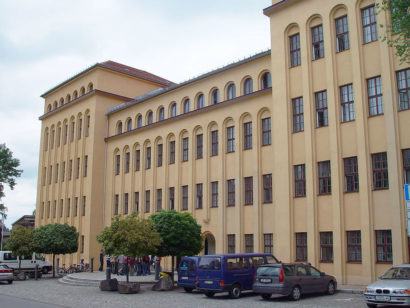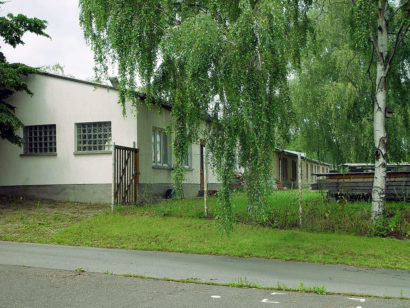Freiberg Subcamp
August 31, 1944 – April 14, 1945
![]()
Freiburg District Administrative Office, 2004 (Photo: Flossenbürg Concentration Camp Memorial). During the war, the airplane manufacturer Arado produced parts in this former porcelain factory.
![]()
The former barracks of the prisoner camp in Freiberg, 2004 (Photo: Flossenbürg Concentration Camp Memorial). After the war, a technical college took over the buildings of the former prisoner barracks. Today, only one building remains.
-
Prisoners
In several transports 1,000 Jewish women were deported from the Auschwitz concentration camp to Freiberg. Over 500 were from Poland, along with 178 Czechs, 158 Slovakians, 90 Germans, 23 Dutch women, and 15 Hungarians, as well as women from four further countries.
-
Forced labor and quarters
Metal work on airplane parts for the aviation company Arado, Potsdam (codename in Freiberg: Freia GmbH); bomb sights for the V2 for the optic company Max Hildebrand; various outdoor labor work (e.g. felling of Christmas trees) for the Freiberg town authority
-
The women were initially quartered in the factory, but from January 1945 they were quartered in a barracks compound two kilometers away that had extremely poor hygienic conditions.
-
Guards
Detail leader Beck, 22 SS guards, 28 female overseers (March 1945).
-
Death toll
Eight deaths are documented into the number registers.
-
Disbanding of the camp / end of the war
The subcamp was evacuated on April 14, 1945. The women were transported by train across the whole of the “Protectorate of Bohemia and Moravia” to Mauthausen, where they arrived on April 29 and were liberated by U.S. troops on May 5, 1945.
-
Commemoration
A commemorative plaque on the former administrative building of the factory memorializes the prisoners of the Freiberg subcamp. Today, the building is the seat of the Freiberg District Administrative Office.
-
An installation in the entrance area of a vocational school on the former camp grounds.

